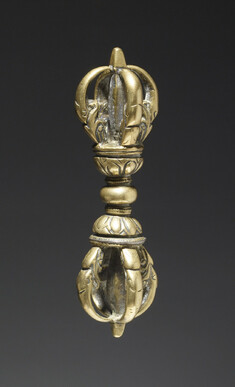Ritual Bell
(India, Nepal, and Tibet)
Hand-held bells such as this one are among the most commonly used implements of Tibetan Buddhist ritual. The bell symbolizes wisdom, the feminine component of enlightenment, and is often used together with the "vajra," which symbolizes compassionate action and intention, the masculine component of enlightenment. Small images of vajras adorn the rim and upper face of this bell; other imagery includes auspicious symbols, protective animal-like faces, and garlands. The handle (in the form of a half-vajra), is well worn, attesting to the bell’s past use.
Provenance
Provenance (from the French provenir, 'to come from/forth') is the chronology of the ownership, custody, or location of a historical object. Learn more about provenance at the Walters.
Acquired by C. P. Ching, Hong Kong; purchased by John and Berthe Ford, Baltimore, October 31 1976; given to Walters Art Museum, 2016.
Conservation
| Date | Description | Narrative |
|---|---|---|
| 1/17/2017 | Examination | examined for acquisition |
Geographies
Tibet (Place of Origin)
Measurements
H excluding clapper and tassel: 6 7/8 × Diam: 3 3/4 in. (17.5 × 9.5 cm)
Credit Line
Gift of John and Berthe Ford, 2016
Accession Number
In libraries, galleries, museums, and archives, an accession number is a unique identifier assigned to each object in the collection.
In libraries, galleries, museums, and archives, an accession number is a unique identifier assigned to each object in the collection.
54.3105



